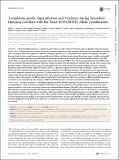Toxoplasma gondii Superinfection and Virulence during Secondary Infection Correlate with the Exact [ROP5 over ROP18] Allelic Combination
Author(s)
Camejo, Ana; Cordeiro, Cynthia; Julien, Lindsay; Grotenbreg, Gijsbert M.; Frickel, Eva-Maria; Young, Lucy; Ploegh, Hidde; Melo, Mariane Bandeira; Saeij, Jeroen; Jensen, Kirk D.; ... Show more Show less
DownloadJensen-2015-Toxoplasma gondii Su.pdf (3.289Mb)
PUBLISHER_CC
Publisher with Creative Commons License
Creative Commons Attribution
Terms of use
Metadata
Show full item recordAbstract
The intracellular parasite Toxoplasma gondii infects a wide variety of vertebrate species globally. Infection in most hosts causes a lifelong chronic infection and generates immunological memory responses that protect the host against new infections. In regions where the organism is endemic, multiple exposures to T. gondii likely occur with great frequency, yet little is known about the interaction between a chronically infected host and the parasite strains from these areas. A widely used model to explore secondary infection entails challenge of chronically infected or vaccinated mice with the highly virulent type I RH strain. Here, we show that although vaccinated or chronically infected C57BL/6 mice are protected against the type I RH strain, they are not protected against challenge with most strains prevalent in South America or another type I strain, GT1. Genetic and genomic analyses implicated the parasite-secreted rhoptry effectors ROP5 and ROP18, which antagonize the host’s gamma interferon-induced immunity-regulated GTPases (IRGs), as primary requirements for virulence during secondary infection. ROP5 and ROP18 promoted parasite superinfection in the brains of challenged survivors. We hypothesize that superinfection may be an important mechanism to generate T. gondii strain diversity, simply because two parasite strains would be present in a single meal consumed by the feline definitive host. Superinfection may drive the genetic diversity of Toxoplasma strains in South America, where most isolates are IRG resistant, compared to North America, where most strains are IRG susceptible and are derived from a few clonal lineages. In summary, ROP5 and ROP18 promote Toxoplasma virulence during reinfection.
Date issued
2015-02Department
Massachusetts Institute of Technology. Department of Biology; Whitehead Institute for Biomedical Research; Koch Institute for Integrative Cancer Research at MITJournal
mBio
Publisher
American Society for Microbiology
Citation
Jensen, Kirk D. C., Ana Camejo, Mariane B. Melo, Cynthia Cordeiro, Lindsay Julien, Gijsbert M. Grotenbreg, Eva-Maria Frickel, Hidde L. Ploegh, Lucy Young, and Jeroen P. J. Saeij. “ Toxoplasma Gondii Superinfection and Virulence During Secondary Infection Correlate with the Exact [ROP5 over ROP18] Allelic Combination .” mBio 6, no. 2 (February 24, 2015): e02280–14.
Version: Final published version
ISSN
2150-7511